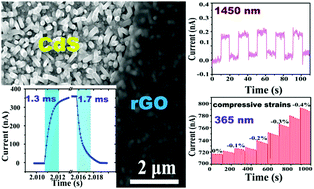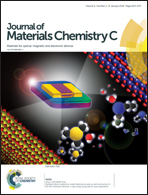A novel high-performance self-powered UV-vis-NIR photodetector based on a CdS nanorod array/reduced graphene oxide film heterojunction and its piezo-phototronic regulation†
Abstract
A Schottky junction based self-powered photodetector fabricated by facile processes that has a response from the UV to infrared region is still a challenge. In this work, a CdS nanorod array/reduced graphene oxide (rGO) film heterojunction was fabricated via spin-coating, affording an ultra broadband self-powered photoresponse from the ultra violet to infrared region (365–1450 nm), which is the first reported in this region for rGO complex materials. Compared with a single-component CdS nanorod array or rGO film alone, a CdS nanorod array/rGO film heterojunction exhibits a very fast and stable self-powered photoresponse (with a response time of less than 1.7 ms), which results from the formation of an interfacial Schottky junction between CdS and rGO. The photocurrent and responsibility under UV radiation can be increased by more than 11% when a 4% compressive strain is deployed, which is ascribed to the Schottky barrier height modification between the CdS and rGO induced by a strain-induced piezopotential. This work provides a simple and effective method for obtaining high-performance self-powered piezo-phototronic broadband heterojunctions.



 Please wait while we load your content...
Please wait while we load your content...